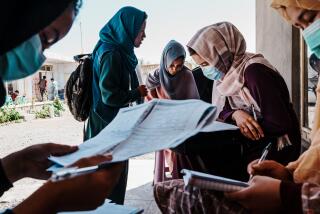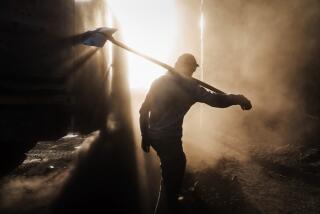Aloof Terrorists Were Town’s Elite
JALALABAD, Afghanistan — Throughout the Taliban years, a large, wealthy community of Al Qaeda members moved to this war-broken city--and thrived. In a land of mud houses and donkey travel, hundreds of expatriate terrorists built compounds and schools for their families on government land, cut deals with local authorities and bumped over Jalalabad’s dirt roads in new pickup trucks.
“We never had a conversation, because they never let Afghan people near them,” said Mohammed Sharif, who lives next door to a Jalalabad compound that was home to 60 Al Qaeda members. “They were Arabs, they were rich, and they didn’t trust anybody.”
Contrary to the image of solitary terrorists toiling in isolation, the men here in Jalalabad lived with their wives and raised their children together. In fact, the famously rootless Al Qaeda sank itself deep into the city’s civic landscape, leading the comfortable life of neocolonialists.
But now, the members of Osama bin Laden’s secretive terrorist network are nowhere to be found. Their Taliban protectors disappeared from Jalalabad last week in a nearly bloodless surrender, leaving the foreigners to fend for themselves.
Some fled to Pakistan. Others reportedly are camped on a remote mountain 25 miles south of town. The men took their guns, their wives and their children. They left behind their artillery, their safe houses and their chemicals.
Like the rest of Afghanistan, the Al Qaeda properties now linger in eerie limbo. The buildings have been seized by the new local government, such as it is. In the sandy hills outside town, a listless guard keeps watch over a deserted terrorist camp. “I’m just watching it,” he said, “until the government decides what to do with it.”
Anti-Taliban fighters too young to shave have stomped through abandoned Al Qaeda homes, smashing windows, shooting chickens and pocketing plastic toys. They aren’t interested in the bomb and artillery manuals--many of them don’t know how to read their own language, let alone Arabic. But they do know their firepower, and they’ve seized huge stockpiles of grenades, mines and artillery.
When visitors stop by a compound near the defunct Taliban intelligence agency here, boastful young guards hoist jugs and boxes of chemicals--magnesium powder, lead nitrate, potassium chlorate--from a basement bomb factory. “What are they?” they ask.
With roses incongruously stuck behind their ears, the soldiers are at play in the ruins of a short-lived empire.
Al Qaeda’s infrastructure here was extensive. The members built at least one school for about 30 pupils. A few dozen brick homes were arranged into a campus on a nearby hillside, and other Al Qaeda members rented houses throughout the city. Married men lived with their families; single men roomed together. With the blessing of the Taliban, the group commandeered old Soviet military facilities for a training camp and an arsenal.
Taliban Ties Lent Clout to Terrorists
When the electricity to the neighborhood containing the compound was switched off, the Al Qaeda members paid a call to the city government, their neighbors recalled. The terrorists reminded the local leaders that they were building houses on Taliban property with the permission of the regime’s supreme leader, Mullah Mohammed Omar. After that, power was restored to the compound.
“Meanwhile,” neighbor Sharif grumbled, “we had to go without electricity in our own country.”
It is unclear how many Al Qaeda members lived in Jalalabad. Certainly there were hundreds--scrupulously organized, powerfully armed and deeply entrenched. They didn’t talk to Afghans, and their children were not allowed to play with the neighborhood kids. They drove new cars. The townspeople called them “the Arabs.”
“Hey, Mr. America, who do you think you are?” demands a manifesto found at one of the homes. “We should follow the example of Sheik Osama bin Laden and wage war against our true enemy.”
The homes in the compound near the intelligence agency seem both menacing and domestic, littered with baby shoes, computer manuals and prayer books. There are address books, bank cards and fake passport stamps; books in French, German, Russian and Arabic; and utility bills. A household budget balances construction expenses of concrete and rock against a $25,000 “gift from Sweden.” There is a French cookbook and a handwritten guide to caring for a 3-month-old baby.
Al Qaeda abandoned the compound just half an hour before the soldiers crashed through the door, guards said. The families left behind photographs of bright-eyed, grinning children. They left their coloring books and plastic train tracks. Forgotten pet rabbits hopped in the yard.
The men also left behind a wealth of clues--mobile phone bills, Deutsche Bank cards, the address of a currency house in the United Arab Emirates, a receipt for a diamond bought in Brussels. Lists of addresses in Islamabad, Pakistan; Stuttgart, Germany; and London. They forgot notebooks filled with painstaking chemical equations, diagrams and Arabic captions.
And, of course, they left behind weapons. In the courtyard of a plain stone house, around the bend from the old police station, 80 mortars are stacked like firewood. Next to them, soldiers sift through a crate of grenades.
Gun Battle Erupts at Terrorists’ House
By the time opposition soldiers stormed the city last week, the two men who lived in the stone house were ready. They’d sent their wives and children ahead. They gripped their Kalashnikovs and waited downstairs with eight other men.
When the soldiers broke into the terrorists’ house, a gun battle erupted. One of the Al Qaeda men fell dead. The other nine escaped. The invading commander was shot in the foot. It was one of the few bursts of violence in the fall of Jalalabad. In less than an hour, the new government had seized the property.
“Maybe we’ll stay here,” commander Mohammed Zaher said Wednesday, lounging with his men on cushions in the terrorists’ old sitting room.
The terrorists also abandoned their training camp on the edge of town. Like much of Afghanistan’s crumbling infrastructure, the camp was a broken-down holdover from foreign occupation, built on the bones of an old Soviet army base. A month earlier, U.S. bombs had chewed through the brick buildings, leaving broken door frames and shattered ceiling beams.
There was a time when foreigners rolled every day past the barbed wire up the hill to the camp. The villagers at the bottom of the road paused sometimes to watch them pass. Mothers forbade their sons to climb the rocky path. Even elders didn’t venture up the hill.
The only local who climbed up to the camp was Rahim Gul, and that was because he had no choice. It was his job to fix platters of spinach, rice and meat for the terrorists-in-training. Cooking at the camp made a dull day for the unemployed civil engineer, but under the Taliban, he said, it was the only job he could find.
“I was not happy there,” Gul said. “They didn’t pay me much, and they never explained their missions to me.”
The terrorist camp all but shut down after Sept. 11. By the time the bombs fell, the villagers and guard say, there wasn’t anybody around to get hit.
More to Read
Sign up for Essential California
The most important California stories and recommendations in your inbox every morning.
You may occasionally receive promotional content from the Los Angeles Times.










